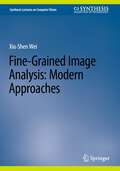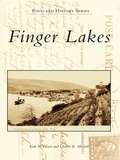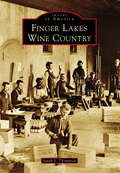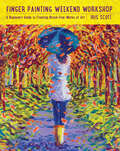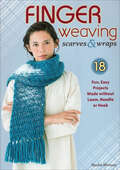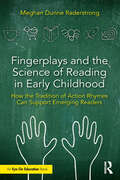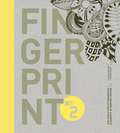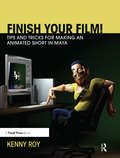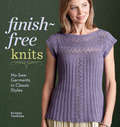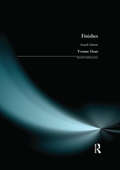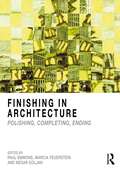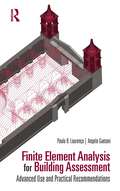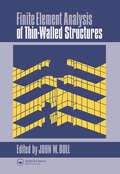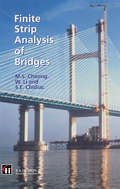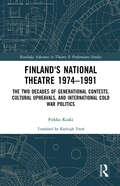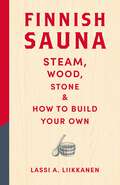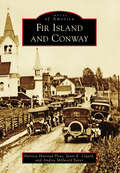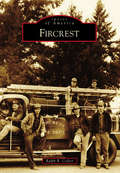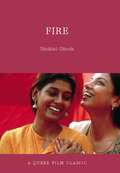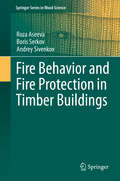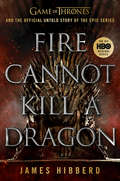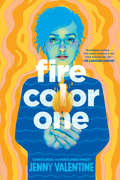- Table View
- List View
Fine-Grained Image Analysis: Modern Approaches (Synthesis Lectures on Computer Vision)
by Xiu-Shen WeiThis book provides a comprehensive overview of the fine-grained image analysis research and modern approaches based on deep learning, spanning the full range of topics needed for designing operational fine-grained image systems. The author begins by providing detailed background information on FGIA, focusing on recognition and retrieval. The author also provides the fundamentals of convolutional neural networks to further make it easier for readers to understand the technical content in the book. The book introduces the main technical paradigms, technological developments, and representative approaches of fine-grained image recognition and fine-grained image retrieval. The author covers multiple popular research topics and includes cross-domain knowledge. The book also highlights advanced applications and topics for future research.
Finger Lakes
by Kirk W. House Charles R. MitchellFor more than a century, the natural scenic beauty of the Finger Lakes has drawn generations of tourists. The vineyards, glens, and steamers that made the region famous are displayed through the vintage images in this volume. These postcards capture the lively and dynamic atmosphere that has kept visitors flocking to the area for years, eager to mail a piece of their memories back home.
Finger Lakes Wine Country (Images of America)
by Sarah ThompsonFor more than 150 years, Finger Lakes Wine Country has played a major role in American wine history. At its heart are the four deepest Finger Lakes, part of a group of 11 long, narrow lakes in central New York. There, nestled among Canandaigua, Keuka, Seneca, and Cayuga Lakes, farmers began planting vineyards in the 1830s. In 1860, the Pleasant Valley Wine Company became America's first bonded winery, turning Keuka Lake into a busy shipping hub for fresh grapes and award-winning champagnes. Other wineries soon followed, as did railroads and basket factories. Early 20th century business was good until Prohibition forced wineries to reinvent themselves. In the 1950s and 1960s, innovators like Charles Fournier, Dr. Konstantin Frank, and Walter S. Taylor experimented with hybrid and European vinifera grape varieties. But by the 1970s, local grape growers faced extinction; it would take a grassroots movement and landmark legislation in 1976 to bring about a Finger Lakes wine renaissance.
Finger Painting Weekend Workshop: A Beginner's Guide to Creating Brush-Free Works of Art
by Iris ScottLearn how to create a simple, brush-free, mistake-free painting in one day working with rich oil colors and using just your fingers.Leave your brushes behind! Iris Scott’s revolutionary finger-painting courses are designed for everyone, especially beginners. Watch your paintings flourish with life when you follow Iris’s simple techniques that let the paint do the work. Complete with five masterpieces and clear, step-by-step instructions for recreating each one, Finger Painting Weekend Workshop makes you feel like you are sitting right in one of Iris’s bestselling finger-painting classes. The concise instructions encourage artists to complete a painting in a single day, making finger painting an ideal project and hobby for novice artists. You’ll be able to create a mistake-free piece in a single day to hang on the wall or give as the ideal handmade gift for a loved one. This book also features beautiful artworks like Koi Fish, Wet Road, Clouds, Red Floral, and Lady in Leaves. Perfect for fans of adult coloring books and other forms of art relaxation, finger painting is a classic form of meditative “play” therapy. So, take the weekend off and get your hands dirty!
Finger Weaving Scarves & Wraps: 18 Fun, Easy Projects Made without Loom, Needle or Hook
by Naoko MinowaDo you want to make scarves and wraps but feel intimidated by knitting needles, looms, or crochet hooks--or are you just always interested in trying a new technique? Finger Weaving Scarves & Wraps will teach you to weave simple patterns from yarn using just your fingers and a few basic tools you already own, such as a ruler on which to tie the yarn and a water bottle to hold the ruler in place while you work--it's that easy! • Easy-to-follow illustrated step-by-step instructions guide you through the process for weaving each of the 18 patterns• Create fashionable handwoven scarves, wraps, and other projects with simple weaving techniques--no loom required• Choose your own colors and yarns for a myriad of personalized accessories
Fingerplays and the Science of Reading in Early Childhood: How the Tradition of Action Rhymes Can Support Emerging Readers
by Meghan Dunne RaderstrongUnlock the magic of fingerplays and transform your early childhood classroom with this essential guide bridging research and practice.While many books compile fingerplays and action rhymes, few explore their rich history or the science behind their impact on early literacy and social development. This groundbreaking guide offers teachers and caregivers a resource that connects tradition with evidence-based practices, examining how fingerplays align with the latest research in the science of reading and offering insights into their effectiveness.Featuring a wealth of research on early literacy and social development, the book includes a practical section filled with selected rhymes and visual cues for easy classroom implementation. Fingerplays and the Science of Reading in Early Childhood is a timeless addition to any early childhood educator’s collection.
Fingerprint Fun (Fountas & Pinnell Classroom, Guided Reading)
by Denise ProwellNIMAC-sourced textbook. Get Ready, Get Set, Print! Get your pointer finger ready! This book will show you how to use it to make great art.
Fingerprint No. 2: The Evolution of Handmade Elements in Graphic Design
by Design Associates ChenFor many designers, creating things by hand is a reaction to too much computer-based design. Since the first Fingerprint was published, ideas that were once on the fringe have begun to thrive in the mainstream. From typography and illustration to book-making and film titles, elements of handcraft have soaked into everyday life.Fingerprint No. 2 reflects the evolution of those ideas. In this second volume, you’ll still find plenty of projects created entirely without the aid of computer technology. But you’ll also discover how designers are beginning to incorporate the two aesthetics-handmade and digital-in order to best communicate their message. A third, hybrid aesthetic is emerging, one that marries the technologies of the past and future into a vibrant, exciting present.Look inside to discover 133 projects and exclusive visual essays from leading designers, including Robynne Raye, Stefan Bucher and Christian Helms. These pieces of work prove that handmade elements are not only vital to excellent design, but often result in exceptional design.Listen for the pulse, which cannot be faked, forged, or falsified. Look for the finger print. It is the key to design’s success.
Fingers Pointing Toward the Sacred: a Twentieth Century Pilgrimage on the Eastern and Western Way
by Frederick FranckTake part in a fascinating spiritual travelogue around the world with renowned artist, sculptor, and author Frederick Franck as he visits Sri Lanka, India, the Himalayas, and Japan. Along the way he relates events of the journey to memories of his life, tying past and present together with a series of flashbacks that add depth and richness to the narrative. Sit in on intimate, probing conversations with the twentieth century giants of faith he has met: Pope John XXIII, the Dalai Lama, Albert Schweitzer, D.T. Suzuki, and many others. In his quest for a spirituality which can be found at the heart of all religions, he moves beyond theological rhetoric to explore the deep spiritual resonances between Buddha-Nature and Christ-Consciousness. This book is the culmination of wisdom from a lifelong internal and external pilgrimage by the author of the classic book, The Zen of Seeing. Including charming drawings which Franck sketched along the way, this is a "road story" in the tradition of the ancient legends of heroes on the path of self-discovery. For all twentieth century pilgrims, Franck's fingers truly do point toward the Sacred.
Finish Your Film! Tips and Tricks for Making an Animated Short in Maya: Tips And Tricks For Making An Animated Short In Maya
by Kenny RoyFinish Your Film! Tips and Tricks for Making an Animated Short in Maya is a first-of-its-kind book that walks the reader step-by-step through the actual production processes of creating a 3D Short film with Maya. Other books focus solely on the creative decisions of 3D Animation and broadly cover the multiple phases of animation production with no real applicable methods for readers to employ. This book shows you how to successfully manage the entire Maya animation pipeline. This book blends together valuable technical tips on film production and real-world shortcuts in a step-by-step approach to make sure you do not get lost. Follow along with author and director Kenny Roy as he creates a short film in front of your eyes using the exact same methods he shows you in the book. Armed with this book, you'll be able to charge forth into the challenge of creating a short film, confident that creativity will show up on screen instead of being stifled by the labyrinth that is a 3D animation pipeline.
Finish-Free Knits: No-Sew Garments in Classic Styles
by Kristen TendykeImagine knitting a beautiful sweater without the stressful obstacles of sewing, seaming, and grafting.Welcome to Knitwear designer Kristen TenDyke's world of Finish-Free Knits! While exploring these 20 designs, you will discover stitch-free solutions to previously frustrating obstacles needed to finish a design.Kristen will teach you to knit sweaters with no assembly required. Through clever planning and some simple techniques, the projects in Finish-Free Knits are shaped and joined during knitting - without sacrificing the pockets, buttonbands, shaped collars, and more that is accomplished in most designs by sewing together separate pieces. In addition, learn how to shape armholes, join pieces as you go, use short-rows for shaping, and more.Once these stress-free finishing techniques are learned, you will enjoy the freedom to apply variations of each method in projects beyond the book. With Finish-Free Knits you can avoid the dreaded "Some Assembly Required" phrase forever.
Finishes (Mitchell's Building Series)
by Yvonne Dean Alan EverettThe fourth edition of this well established text brings the subject up-to-date with environmental legislation and provides a thorough understanding of the surface technologies of all materials used for finishes. It also aims to minimise the use of finishes which have shorter lives and hence need renewing more frequently. As the variety of materials used for finishes is so large, they have been grouped into their engineering categories of ceramics, polymers, metals and composites to aid understanding of their structure, behaviour and ability to resist degradation.Finishes is an essential textbook for Materials units on building, architecture, surveying and related degree and postgraduate courses, and for students of BTEC HNC/D building and surveying.
Finishing in Architecture: Polishing, Completing, Ending
by Paul Emmons Marcia Feuerstein Negar Goljan Camila MancillaFinishing in Architecture: Polishing, Completing, Ending explores the topic of finishing and the fascinating physical and metaphysical implications of its various conceptions in architecture. Finishing is essential to all human practices and concepts of time, yet simultaneously it is largely impossible to identify an entirely finished state of being. As mortals, we organize our worlds into beginnings and endings, starts and finishes. Architecture’s temporality, however, may contain something of both the mortal and immortal within it – a desire for permanence combined with lamentation over its impossibility.While many approaches to finishing construct two opposed ontological conditions (the finished and the unfinished), this dualistic ploy neglects the complexity of architectural practice, cultural reception, and historiographic shifts in semiotics during the lifetime of a building. More nuanced approaches are examined in this collection of 38 essays and creative works from a diverse group of scholars, architects, and artists who conceptualize finishing not simply as a final outcome, but as an extended action, a mood that presumes an end is near, all the while working continuously toward (but never achieving) completion. It is here that the concept of finishing is not a state of being but a state of becoming, as an active thickening of time when the end is thought to be imminent but not yet attained. Finishing, more than a final endpoint, is a void state that is extended through efforts framing its territory, while never quite containing it.From the material to the procedural and the conceptual, this volume explores the practices of finishing in architecture within three currents: surfaces, projects, and most broadly, architectural times. It will be of interest to students and instructors of architecture and design, architectural historians, and other scholars.
Finite Element Analysis for Building Assessment: Advanced Use and Practical Recommendations (Assessment, Repair and Strengthening for the Conservation of Structures)
by Paulo B. Lourenço Angelo GaetaniExisting structures represent a heterogeneous category in the global built environment as often characterized by the presence of archaic materials, damage and disconnections, uncommon construction techniques and subsequent interventions throughout the building history. In this scenario, the common linear elastic analysis approach adopted for new buildings is incapable of an accurate estimation of structural capacity, leading to overconservative results, invasive structural strengthening, added intervention costs, excessive interference to building users and possible losses in terms of aesthetics or heritage values. For a rational and sustainable use of the resources, this book deals with advanced numerical simulations, adopting a practical approach to introduce the fundamentals of Finite Element Method, nonlinear solution procedures and constitutive material models. Recommended material properties for masonry, timber, reinforced concrete, iron and steel are discussed according to experimental evidence, building standards and codes of practice. The examples examined throughout the book and in the conclusive chapter support the analyst’s decision-making process toward a safe and efficient use of finite element analysis. Written primarily for practicing engineers, the book is of value to students in engineering and technical architecture with solid knowledge in the field of continuum mechanics and structural design.
Finite Element Analysis of Thin-Walled Structures
by John W. BullThis book describes current developments in finite element analysis and the design of certain types of thin-walled structures. The first three chapters lay the foundations for the development and use of finite elements for thin-walled structures, look at finite elements packages and discuss data input and mesh arrangements. The final four chapters use the finite element method to assist in the solution of thin-walled structure problems. Some of the problems solved include; water and air inflated structures; axisymmetric thin shells; ship structures and offshore structures. This book will be an interest to design engineers, researchers and postgraduates.
Finite Strip Analysis of Bridges
by M.S. Cheung S.E. Chidiac W. LiIn-depth, comprehensive and up-to-date information on the powerful finite strip method of analysis of bridges. It is in three parts. The first introduces the method and gives the necessary background. The second explains the evolution of the method and the third part provides detailed information on the application of the method to highway bridges.
Finland's National Theatre 1974–1991: The Two Decades of Generational Contests, Cultural Upheavals, and International Cold War Politics (Routledge Advances in Theatre & Performance Studies)
by Pirkko KoskiThis study analyses the Finnish National Theatre’s activities throughout the decades during which the post-war generation with its new societal and theatrical views was rising to power, and during which Europe, divided by the Iron Curtain, was maturing to break the boundaries dividing it. Pirkko Koski summarizes the activities of the Finnish National Theatre as a cultural factor and as a part of the Finnish theatre field during 1970s and 1980s. Alongside this he examines the general requirements, resources and structures for activity, including artists, places, geographical position, performances and the analysis on the societal conditions. This book will be of great interest to scholars and students of European theatre and history.
Finnish Sauna: Steam, Wood, Stone and How to Build Your Own
by Lassi A. LiikkanenAs the old Finnish proverb has it: First build the sauna. Then the house.More and more people around the world are rediscovering an ancient secret to wellbeing, relaxation and stress relief: the humble sauna. By gently raising the heart rate and relaxing muscles, the magical steam that rises from the heated stones - what Finns call löyly - has improved quality of life in the Nordic region for millennia.In this practical guide, leading global expert Lassi Liikkanen teaches us how to plan, build and maintain a new sauna, with detail on insulation, panelling, and bench construction, and uses the examples of an indoor electric sauna and an outdoor sauna cabin with a wood-burning heater. Along the way, you will learn the traditions and science of sauna, and for the first time Dr Liikkanen introduces his history of Finnish sauna as defined by four eras.Whether you're already planning to build your own, or just beginning to learn of the health benefits of sauna, this book is the perfect introduction to löyly and the very Finnish art of living well. Prepare to embrace the deep sense of calm and connection that comes from this simple marriage of steam, wood and stone.
Finnish Sauna: Steam, Wood, Stone and How to Build Your Own
by Lassi A. LiikkanenAs the old Finnish proverb has it: First build the sauna. Then the house.More and more people around the world are rediscovering an ancient secret to wellbeing, relaxation and stress relief: the humble sauna. By gently raising the heart rate and relaxing muscles, the magical steam that rises from the heated stones - what Finns call löyly - has improved quality of life in the Nordic region for millennia.In this practical guide, leading global expert Lassi Liikkanen teaches us how to plan, build and maintain a new sauna, with detail on insulation, panelling, and bench construction, and uses the examples of an indoor electric sauna and an outdoor sauna cabin with a wood-burning heater. Along the way, you will learn the traditions and science of sauna, and for the first time Dr Liikkanen introduces his history of Finnish sauna as defined by four eras.Whether you're already planning to build your own, or just beginning to learn of the health benefits of sauna, this book is the perfect introduction to löyly and the very Finnish art of living well. Prepare to embrace the deep sense of calm and connection that comes from this simple marriage of steam, wood and stone.
Fir Island and Conway (Images of America)
by Andrea Millward Xaver Janet K. Utgard Patricia Hanstad PleasThe North Fork and the South Fork of the Skagit River were navigated by those searching for gold and land in the 1870s. Flooding became a deterrent for many, but those who stayed discovered an abundance of fertile soil and natural resources. Scandinavian immigrants, predominantly Norwegian, came to settle in the area, some with their families, and worked in logging and in farming. As the population grew, small towns and businesses were soon established. Skagit City and Fir were located on Fir Island; Conway and Milltown were located east of the island. In 1914, a bridge connected the island to the mainland, replacing the ferry at Mann’s Landing. After many floods, the removal of logjams, and the arrival of the Great Northern Railroad, Mount Vernon began to prosper upriver, and the little towns began to disappear. Today, Fir Island and Conway are destinations for tourists who come to see snow geese and trumpeter swans during migration. Farmers continue to work the soil, and many descendants of pioneers still remain.
Fircrest
by Ralph R. ColyerFircrest was ready and waiting when America exploded into the modern era following World War II. In 1906, the creative energy of Edward "Major" Bowes, of Amateur Hour fame, combined with the engineering brilliance of Mat R. Thompson to create the quintessential American suburb. Anticipating America's love affair with the automobile, they designed a modern "suburban park" with wide streets that curved with the contours of the land. Brisk initial sales faded, and the development, Regents Park, struggled. But the people of "the Park" persevered. In 1925, the Fircrest Golf Club was started, and the homeowners joined together to incorporate. Seeking a fresh start, they renamed their village the City of Fircrest. Postwar homebuilders discovered a solid community with a modern plan and available shovel-ready lots. When the dust settled, the iconic midcentury American neighborhood that Bowes and Thompson envisioned stood proud.
Fire
by Shohini GhoshA Queer Film Classic: the 1996 film by Indian-born director Deepa Mehta, about the burgeoning relationship between the wives of two brothers; its unprecedented lesbian themes led to riots outside cinemas in India.
Fire Behavior and Fire Protection in Timber Buildings
by Roza Aseeva Boris Serkov Andrey SivenkovThis volume describes fire behavior and fire protection of timbers in outdoors and indoors application mainly in construction industry. The Authors' novel approach considers the relationship between various species and age of timbers and its fire behavior at different thermal and fire loads. Quantitative data of ignition speed and flame propagation as well as generation of heat, smoke and toxic products are discussed. Analysis of fire resistance of various types of building materials based on timber of different species as well as the novel data on the effect of natural and accelerated aging of timbers on its fire behavior are discussed. The main practical methods of fire protection of new and ancient timber buildings and structures to increase its fire resistance are considered. The book should be useful for a wide range of readers: chemists, physicists, material scientists, architects, engineers, constructors and restorers.
Fire Cannot Kill a Dragon: Game of Thrones and the Official Untold Story of the Epic Series
by James HibberdPraise from George R.R. Martin: "James Hibberd covered Game of Thrones from start to finish, and he knows where all the bodies are buried. It's all here, in his oral history of the series: how it began, how it ended, dragons and direwolves, what went on in front of the cameras and what went on behind the scenes, the triumphs and the stumbles, the tough decisions, the forks in the road, the reasons why. Actors, directors, showrunners, producers, executives, even me... Fire Cannot Kill a Dragon has it all, everything you ever wanted to know. Game of Thrones was an amazing ride. Fire Cannot Kill a Dragon is an amazing read.&” The official, definitive oral history of the blockbuster show from Entertainment Weekly&’s James Hibberd. It was supposed to be impossible. George R.R. Martin was a frustrated television writer who created his bestselling A Song of Ice and Fire fantasy novels to be an unfilmable saga bound only by the limits of his vast imagination. Then a pair of first-time TV writers teamed with HBO to try and adapt Martin&’s epic. We&’ve all seen the eight seasons of the Emmy-winning fantasy series that came next. But there is one Game of Thrones tale that has yet to be told: the 13-year behind-the-scenes struggle to pull off this extraordinary phenomenon. In Fire Cannot Kill a Dragon, award-winning Entertainment Weekly writer James Hibberd chronicles the untold and uncensored story of Game of Thrones, from the creative team&’s first meetings to staging the series finale and all the on-camera battles and off-camera struggles in between. The book draws from more than 50 revealing new interviews, rare and stunning photos, and unprecedented access to the producers, cast, and crew who took an impossible idea and made it into the biggest show in the world.
Fire Color One
by Jenny ValentineNominated for the prestigious Carnegie Medal, this novel is a stunning tribute to fathers and daughters, and to the unique power of art to connect and change us.Sixteen-year-old Iris itches constantly for the strike of a match. But when she’s caught setting one too many fires, she’s dragged away to London before she can get arrested. At least, that’s the story her mother tells. Soon Iris finds herself in the English countryside, where her millionaire father—a man she’s never met—lives. Though not for very much longer. Iris’s father is dying, and her self-interested mother is determined to claim his life’s fortune, including his priceless art collection. Forced to live with him as part of an exploitive scheme, Iris quickly realizes her father is far different from the man she’s been schooled to hate, and everything she thought she knew—about her father and herself—is suddenly unclear. But there may be hidden beauty in Iris’s uncertain past and hopeful future, if only she can see beyond the flames.
